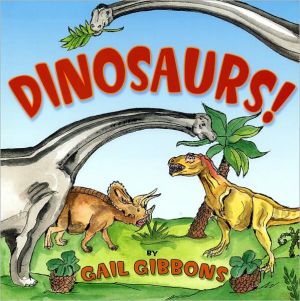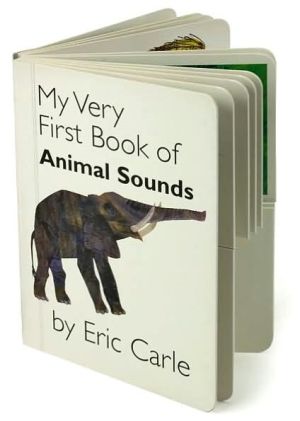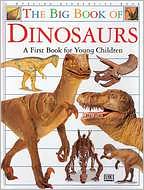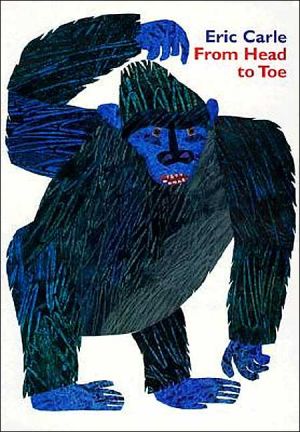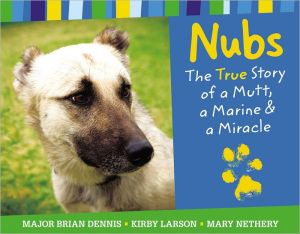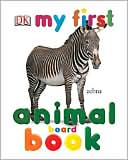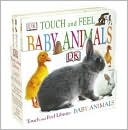Dinosaurs!
Perfect for very young paleontologists, Gibbons's simple yet informative text and vividly detailed illustrations depict the most up-to-date information available about these magnificent creatures.\ \ Introduces in simple text and illustrations the characteristics and habits of a variety of dinosaurs.\
Search in google:
Perfect for very young paleontologists, Gibbons's simple yet informative text and vividly detailed illustrations depict the most up-to-date information available about these magnificent creatures.Publishers WeeklyGibbons begins with a clear introduction to dinosaurs and paleontology for young readers. Two-page spreads illustrate and highlight well-known dinosaurs and give an idea of each one's size, habitat, eating habits and behavioras well as a phonetic pronunciation of its name. In closing, Gibbons describes the two leading theories on the decline of the dinosaurs: either the planet grew too hot or meteoritic dust in the atmosphere caused it to cool down. An appendix describes the information gained from fossilized dinosaur footprints. Pleasant and informative, but the number of more elaborate dinosaur books render this one mostly supplemental. Ages 4-8. (October)
\ Publishers Weekly\ - Publisher's Weekly\ Gibbons begins with a clear introduction to dinosaurs and paleontology for young readers. Two-page spreads illustrate and highlight well-known dinosaurs and give an idea of each one's size, habitat, eating habits and behavioras well as a phonetic pronunciation of its name. In closing, Gibbons describes the two leading theories on the decline of the dinosaurs: either the planet grew too hot or meteoritic dust in the atmosphere caused it to cool down. An appendix describes the information gained from fossilized dinosaur footprints. Pleasant and informative, but the number of more elaborate dinosaur books render this one mostly supplemental. Ages 4-8. (October)\ \ \ \ \ BooklistThe combination of clear writing and lively artwork makes this an accessible choice for young dinosaur enthusiasts.\ \ \ Children's Literature\ - Phyllis J. Perry\ Young paleontologists who can't get enough of dinosaurs will be attracted to this appealing book. It contains a lot of up-to-date, clearly presented information and looks at the topic from several points of view. Readers will see the dinosaurs ranged in size from some of the smallest, like Anchisaurus, to the largest (Argentiosaurus). There is a brief but clear explanation of how fossils are formed and how paleontologists carry out their studies in the field and present their finds in museums. Hatching and caring for the young are discussed as well as a theory of how dinosaurs became extinct, and the distinctions between non-bird dinosaurs that lived on land and bird dinosaurs. Of particular interest, and making it an excellent recommended addition to the dinosaur bookshelf, is the way the central section of the book organizes the non-bird dinosaurs into groups: prosauropods (early plant eaters), theropods (meat eaters), sauropods (large plant eaters with long necks and tails), stegosaurs (plant eaters having plates and sometimes spikes), ankylosaurs (heavily armored plant eaters), ceratopsians (plant eaters having horns and frills), and ornithopods (plant eaters with bills and beaks). A pronunciation aid is given immediately after each use of a dinosaur name so that the reader does not need to turn elsewhere for help, and there is a page of interesting additional facts about dinosaurs at the end of the book. The illustrations are simple and colorful. Gail Gibbons is the author of a large number of books for young science readers including Spiders, Giant Pandas and The Moon Book. Reviewer: Phyllis J. Perry\ \ \ \ \ School Library JournalGr 2-4\ This is a simpler book than the author's Dinosaur Discoveries (Holiday House, 2005) but still adheres to the "nonbird" dinos, meaning those without feathers. Gibbons present a parade of Prosauropods, Therapods, Sauropods, Ceratopsians, and others for neophyte perusal, along with notes on the fossilization process, paleontology in general, and dinosaurian behaviors. Her rather slapdash illustrations do not include a time line, so young readers may not be aware that a variety of Ankylosaurs existed from the Middle Jurassic to the end of the Cretaceous (a period of some 150-plus million years) and did not all exist at one moment in time. Statements indicating that Prosauropods were plant-eaters may be confusing when a blade-toothed Herrerasaurus (admittedly a confusing critter in his own right) is included in the illustration. Gibbons's books have proved popular in the past, and this new one should prove attractive as well.-Patricia Manning, formerly at Eastchester Public Library, NY\ \ \ \ \ \ School Library JournalPreS-Gr 2 Like Parish's Dinosaur Time (Harper, 1974), Gibbons introduces one or two dinosaurs per page, providing a few brief bits of information about each creature, along with a pronunciation guide. She also includes simple information about fossils and paleontology, explaining how scientists deduce facts from dinosaurs' fossilized remains and footprints. Although bright and colorful, the illustrations are disappointingly bland. Flora is generic and uninspired; the sky is always a flat, cheerful blue. The dinosaurs, too, lack the ferocious grandeur that children find so appealing. Brachiosaurus and Tyrannosaurus rex, described respectively as ``one of the biggest of all dinosaurs'' and ``the most terrible animal that ever roamed the earth'' seem neither grand in stature nor horrifying of tooth and claw. The text also lacks innovation. Gibbons presents little new material on dinosaurs, rehashing dinosaurs' tired old reputations, instead of exploring newer findings. An example: Tyrannosaurus rex is still characterized as ``the terror of the planet,'' despite recent discoveries indicating that the creature may have been, at least in part, a scavenger. Despite its drawbacks, this book should find an audience with beginning readers, very young children, and the meek of heart. Readers who prefer their carnivores horrendous and huge will be better served by Peters' Giants (Knopf, 1986) or Cohen's Dinosaurs (Doubleday, 1987). Cathryn A. Camper, Minneapolis Public Library\ \ \ \ \ Kirkus ReviewsGibbons replaces her 1987 take on the topic (Dinosaurs-without the exclamation point) with a more populous and-usually-livelier primer. Along with devoting a page or spread to each of seven main groups, she shows paleontologists in action, portrays the great extinction of 65 million years ago and closes with a page of random dino-facts. There is some meat-eating going on in one spread, but most of the dinosaurs pose in stately, nondisturbing dignity, displaying faint skin patterning or none, against simplified landscapes. Sometimes clarity is sacrificed to simplicity: In one potential point of confusion, Theropods, the ancestors of birds, are billed as "nonbird," despite a later page about the "birdlike" Archaeopteryx. This very basic overview comes with a few dozen dino-names (with pronunciation guides) to practice, and leads naturally into the author's more detailed Dinosaur Discoveries (2005). (Informational picture book. 3-7)\ \
